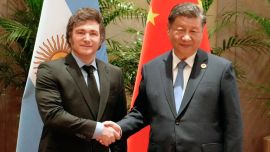The right to protest is part of Argentine democracy and a right of trademark importance in a country which has had military dictatorships, conflicts and tensions.
Democracy was recovered in 1983 thanks to demonstrations while middle-class cacerolazo saucepan-bashing protesters were a central feature of 2001. Furthermore, the right to protest has a constitutional ranking and is enshrined in international treaties which privilege it and recognise it as intrinsic to democracy.
The right to circulate freely has an important history, already being installed in the first written constitution of 1853. That right refers to travel nationwide via the navigable rivers and roads with merchandise and products. It is thus the more commercial right, also related to commuting to work. The issue is that both rights are legitimate and the problem is when they clash. I have a right to protest and to move freely.
That is the clash of two worlds. When you have to travel along a protest route, a dispute for space begins which can lead to confrontation.
The best example is the Avenida 9 de Julio, disputed between demonstrators and commuters. The idea here is to enforce a protocol since these are acquired rights for all citizens. Yet not the military way but in a dynamic form so that social protest can be expressed on the street.
They say that everything is quantitative or qualitative, depending on whether 5,000 people or a million citizens protest. With 5,000 people the protest can be criminalised – when there’s a million, you’ve got the French Revolution. In other words, everything has to be measured by the protest and by the traffic.
When two rights clash, the government must act with authority and prudence, not repress or sanction as the first solution. Dialogue, always dialogue, between the people and the competent authority.
* Lawyer and author, Universidad de Belgrano - UBA
related news
by Eduardo Cantis*





















Comments